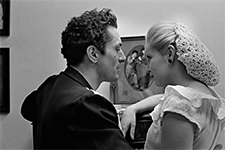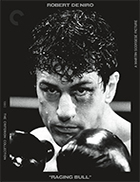Raging Bull
|  The great irony of Raging Bull is that 38-year-old Martin Scorsese believed it would be his final feature film. Despite having won the Palm d’Or for Taxi Driver (1976), which elevated him to the heights of the New Hollywood, Scorsese was in an existential crisis following the massive critical and commercial disappointment of his follow-up film, New York, New York (1977), an homage to Old Hollywood musicals into which he had poured his heart and soul. Fearing the end was near, he turned to a project that actor Robert De Niro had proposed to him while he was making Alice Doesn’t Live Here Anymore (1974): an adaptation of contentious middleweight boxer Jake La Motta’s 1970 autobiography. Despite Scorsese’s initial reservations, Raging Bull became a repository for his artistic intensity and vast knowledge of film history, a dark well into which he poured everything he had, thinking he would never have the opportunity to make another film. Instead of being the end of his career, it reinvigorated it, reestablishing his preeminence among American directors. At the end of the decade, Raging Bull topped two different critics’ lists of the greatest films of the 1980s. In every conceivable way, Raging Bull both disregards convention and embraces the many contours of cinema history. The screenplay, originally penned by Scorsese’s regular collaborator Mardik Martin (Mean Streets, New York, New York) before being substantially rewritten by Taxi Driver scribe Paul Schrader, defies the typical structure of the psychological biopic, cutting out virtually all of Jake La Motta’s formative years and instead dropping us initially into his post-boxing career as a battered, overweight nightclub owner in Miami circa 1964 before jarring us back to his dominance in the ring circa 1941, when he was young, muscular, and on the cusp of winning the middleweight crown. That initial juxtaposition is crucial, because it shows us from the outset where La Motta will end up, which stands in stark contrast to the lyrical opening credits, which show him dancing in the ring in slow motion, his grace matched by the soaring chords of the “Intermezzo” from the opera Cavalleria rusticana by Pietro Mascagni. Beauty and brutality collide head-on, which belies Scorsese’s professed disinterest and lack of knowledge of the world of boxing (which is partially why he resisted making the film for so long). Aesthetically, Raging Bull is a masterpiece of cinematography, sound, and editing. Scorsese’s crucial decision to shoot the film in black and white was driven by both aesthetic reasons to align it visually with the public’s memory of monochromatic newsreels and television broadcasts of that era and commercial reasons to distinguish it from the numerous post-Rocky boxing films that flooded the market in the late 1970s. Cinematographer Michael Chapman had previously shot Scorsese’s Taxi Driver and his concert documentary The Last Waltz (1978), as well as Philip Kaufman’s Invasion of the Body Snatchers (1978) and Paul Schrader’s Hardcore (1979). Raging Bull is arguably his best work, as he produced images of intense clarity and depth that are simultaneously lyrical and dreamlike. The manner in which he lit the boxing matches, where everything falls off into darkness just beyond the ropes, produces an evocative sense of loneliness and isolation despite being surrounded by barely controlled chaos (which we hear on the soundtrack). The depiction of New York City in the 1940s and ’50s has a documentary-like quality that draws us directly into the action in a way that circumvents our awareness of the film’s highly attuned aesthetic design. Channeling both classical Hollywood style and European art film, Raging Bull is a compendium of compelling imagery that editor Thelma Schoonmaker, a regular Scorsese collaborator who won the first of her three Oscars for her work here, stitches together with deft fluidity. The tragic arc of Jake La Motta’s life is fueled by a constant stream of violence and jealousy. The viciousness with which he beat opponents in the ring and his ability to withstand intense pummeling follow him outside the ropes, particularly in his vexed relationships with the women in his life: his first wife, Irma (Lori Anne Flax), and his second wife, Vickie (Cathy Moriarty), who he meets as a teenager when he is still married to Irma. Whenever we are not in the ring with La Motta, we are witnessing a different, but no less violent, match in which he struggles to maintain a relationship with Vickie, who he can only see as an object to be possessed. It is in these moments that De Niro’s Oscar-winning performance is at its sharpest, as we see La Motta watching—always, always watching—Vickie, and we can imagine the gears in his brain racing, filling in all manner of paranoid worries about her infidelity, worries that eventually spiral into a torrent of violent rage. Much has been made about De Niro’s physical transformation—from muscular and agile, the result of a full year of training with the real-life La Motta, to the soft and portly, the result of months of stuffing himself with rich European food that packed on 60 pounds—but the real strength of his performance is in his eyes: his stare, which is unrelenting and eventually terrifying. La Motta’s boxing nickname “The Raging Bull” describes him both inside and outside of the ring, suggesting an inability to control his inherent violence, which is what destroys all of his relationships, including the one with Joey (Joe Pesci), his brother and manager. Joey understands Jake, especially that there is little he can do to control him, which irks the local mobsters who want to control Jake in order to fix fights. When he is eventually convinced to throw a fight, he wails in the locker room like a hurt child, both indignant and pathetic, a foreshadowing of one of the film’s final scenes that finds him in a Miami prison, pounding senselessly at the concrete wall and screaming, “Why, why, why?” The film pointedly refuses to answer that question in direct terms, which is why it sticks with us so profoundly after the credits have rolled. For all that we see of Jake over more than two hours, he remains enigmatic, frustrating, detestable, but utterly compelling.
Copyright © 2022 James Kendrick Thoughts? E-mail James Kendrick All images copyright © The Criterion Collection | |||||||||||||||||||||||||||||
Overall Rating: 


 (4)
(4)


